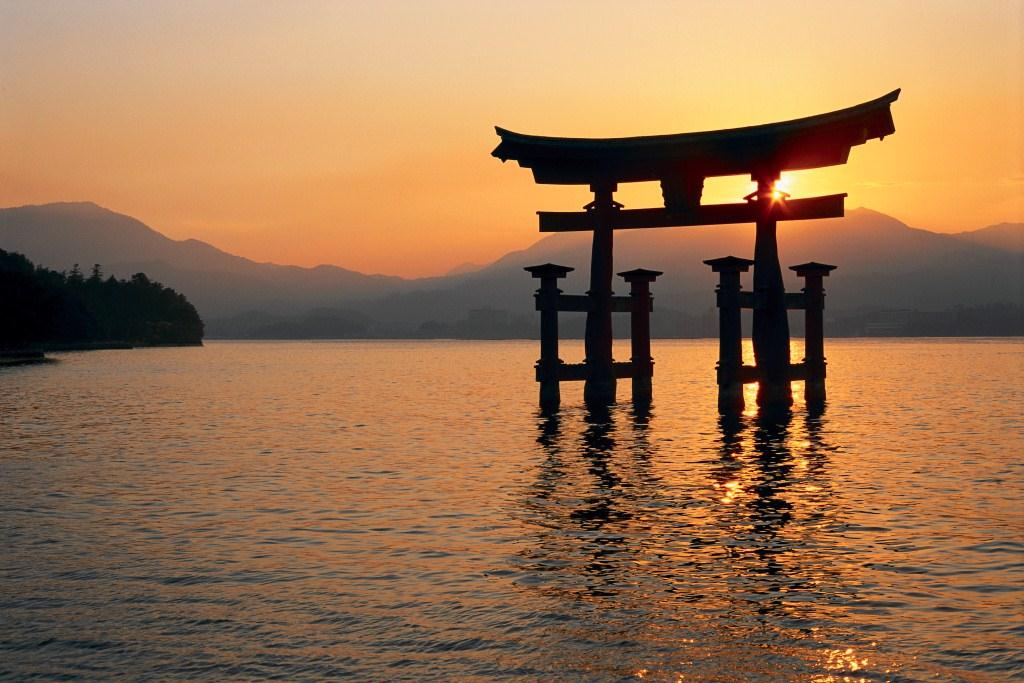

The Japanese call their country Nippon, which means origin of the sun.

Curated/Reviewed by Matthew A. McIntosh
Public Historian
Brewminate
Introduction

There are four major islands and thousands of small ones in the Japanese archipelago(/ar*kuh*peh*luh*goh/). The largest island is Honshu (/hahn*shoo/), the home of the capital city of Tokyo (/toh*kee*oh/),Kyoto (/kee*yoh*toh/), and other great cities. To the south lie the major islands of Shikoku (/shih*koh*koo/) and Kyushu(/kee*yoo*shoo/), and to the north is Hokkaido (/hah*kye*doh/).
Today these islands make up one of the most economically advanced nations in the world. Japanese companies ship automobiles and electronic goods all over the world, and hundreds of thousands of travelers fly in and out of Tokyo’s busy airports everyday. But Japan was not always so open to foreigners. For several centuries, Japan distrusted outsiders and lived in self-imposed isolation. At various times in their history, the Japanese were deeply influenced by their near neighbors—the Koreans and the Chinese.But they shut their doors almost completely to Europeans and Americans between the 1600s and the mid-1800s.
History and Legends
Throughout much of their early history, the Japanese lived in social groups of families and friends called clans. Each clan had its own chief. It also worshiped one god or goddess as its ancestor—its link to heaven.
In about 400 CE, the Yamato (/yah*mah*toh/) clan, which lived on the central island of Honshu, became the strongest of the clans. The Yamatos identified themselves as descendants of the goddess Amaterasu (/ah*mah*ter*ah*soo/) and declared their right to rule Japan.
The Legend of Amaterasu

The Yamatos supported their claim to the throne with a mystical legend. According to this legend, a god and goddess were strolling on the rainbow bridge that led from the sky to the dark sea below. They dipped a jeweled spear into the ocean and shook it into the sky. Drops of sea spray became the first island of Japan. The goddess then gave birth to the rest of the islands.
The godly pair created children to help rule the islands. One was Amaterasu, goddess of the sun, who lived in the sky. As time passed, Amaterasu bore many gods and goddesses. Among her first children was one man.He became Japan’s first emperor.
In 645 CE, because of his family’s power and the legend of Amaterasu, the head of the Yamato clan became emperor of Japan. He called himself the son of heaven and chose the rising sun as the symbol of his empire.For centuries, the Japanese honored their emperors as living gods. Today’s emperor still traces his roots to the Yamato clan.
Borrowing from Neighbors
During this early period of Japanese history, the Japanese borrowed or were inspired by certain things that came fromKorea or from China. It appears that the early Japanese had no written language. Inspired by China’s writing system, the Japanese used simplified forms of Chinese characters to create a writing system of their own. Korean craftsmen taught the Japanese to make tools and ornaments of bronze and iron.
However, the Korean import that had the greatest effect on Japan was a new religion. The Japanese had long practiced a nature religion known as Shinto. In about 550 CE, the Koreans introduced a Chinese form of Buddhism.

One day a Korean boat dropped anchor on the Japanese shore.Korean sailors moved a large box down the gangplank. A gong sounded. Priests chanted as a gold and copper statue of Buddha was lifted from the box and displayed to the people.
The new religion spread slowly, but eventually it took root in Japan. The ceremonies of Buddhism with the gongs, priestly robes, and candlelit altars attracted many Japanese. The religion itself attracted many people, as Buddhism promotes the personal search for a state of peacefulness, without suffering. The new religion also increased Japan’s fascination with mainland culture and especially with all things Chinese.
In the 600s, Prince Shotoku (/sho*toh*koo/), a powerful Yamato prince, became fascinated with China. He realized that much of what the Japanese had learned from the Koreans was actually coming from China. Instead of learning about Chinese ideas indirectly, through the Koreans, the emperor decided to go directly to the source. He sent young Japanese nobles to China to study its culture.
After this expedition, Chinese ways became examples to follow. The Japanese built their first capital city at Nara, laid out like the capital of China. Japanese nobles began dressing in Chinese fashions. The Japanese studied Chinese philosophies,literature, geography, medicine, and astronomy. They imitated Chinese patterns of government and adopted the Chinese calendar. They imported the custom of tea drinking and created elaborate tea ceremonies. They even learned to raise silkworms and weave silk.
Japanese Culture

All of these imported ideas helped Japan grow stronger. Eventually, the country no longer felt the need to rely so heavily on its mainland neighbors. After the 800s, the Japanese changed some Chinese ways to suit Japanese needs and styles. For instance, instead of choosing government officials based on tests of ability, as the Chinese had done, the Japanese decided to fill the government positions with the sons of Japanese nobles. This meant that aristocrats controlled the government.
There were cultural changes as well. Japanese artists added color to the traditional black ink of Chinese paintings. They wrote theirown poems and sculpted in bronze. Wealthy landowners supported artists and encouraged a Japanese style.All of these changes led to the development of a unique Japanese culture.
Originally published by the Core Knowledge Foundation under the terms of a Creative Commons Attribution-NonCommercial-ShareAlike 4.0 International license.






